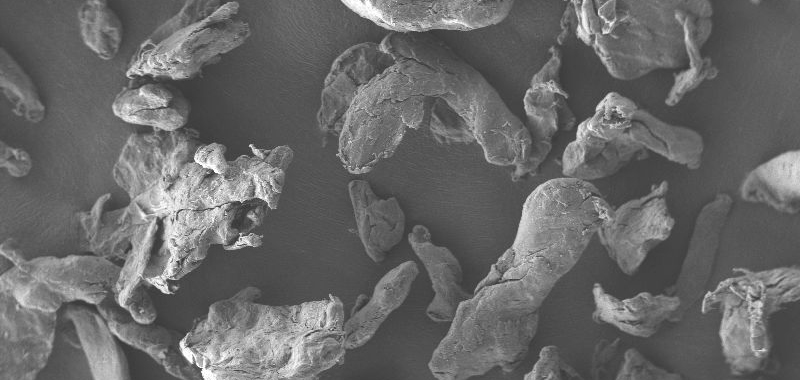Fraunhofer IMWS tests environmentally friendly microplastic alternatives in cosmetic products
Microplastics are still used in personal care products, although the environmental impact is well known. Tiny plastic particles from peelings and other skincare products enter the sea and ultimately our food chain via waste-water systems. In a research project, the Fraunhofer Institute for Microstructure of Materials and Systems IMWS and its partners have tested materials that can replace microplastics in cosmetic products and are biodegradable.

Many cosmetic products such as body peelings or deodorants contain tiny plastic particles, so-called microplastics, for example made of polyethylene (PE) and polypropylene (PP). As "gentle abrasives", they remove dead skin flakes by means of friction and stimulate the blood circulation of the skin. Due to their chemical resistance and their lack of color, smell and taste, they are also frequently used as stabilizers and fillers. Polyethylene and polypropylene are non-biodegradable and due to the small particle size of less than 5 millimeters, the microplastic that has been introduced into waste water with cosmetics cannot be sufficiently removed in sewage treatment plants. It therefore reaches the environment and enters our waters. In the sea, microplastic particles are absorbed by living organisms and eventually enter our food chain. Many cosmetics manufacturers have therefore announced that they will abandon the use of microplastics and instead use suitable alternatives in the future.
With the recently completed research project "KosLigCel" within the framework of the leading-edge cluster BioEconomy, the Fraunhofer Institute for Microstructure of Materials and Systems IMWS is making a contribution to this. In the project, which is funded by the Federal Ministry of Education and Research, alternatives made of biodegradable materials were successfully developed and tested together with CFF GmbH, a cellulose processor from Gehren in Thuringia, and Skinomics GmbH from Halle (Saale), which is mainly responsible for galenic and dermatological examinations of products.
The goal was a cost-effective production of biodegradable cellulose particles from beech wood, oats, wheat and maize that meet the requirements for abrasiveness and cleaning performance in dental and skincare products. Specifically, alternatives for body peelings and toothpastes were tested. The particular challenge was to design the cellulose particles in such a way that their size, shape, hardness and surface structure lead to the desired product properties. Cellulose made of beech wood was specially modified and the optimization process was accompanied by microstructure analysis at Fraunhofer IMWS.
"After two years of research work with the project partners, we have achieved very good results: a test toothpaste with the optimized beech wood cellulose particles is characterized by a low abrasion effect, but nevertheless good cleaning performance," says Dr. Sandra Sarembe, project coordinator at Fraunhofer IMWS. The biodegradable particles in toothpaste are used for the mechanical removal of bacterial plaque, tooth discoloration and food residues, but they may not damage tooth enamel. "In the material characterization of several cellulose types, we have consistently collected positive data. This also applies to the use of these substances in wash peelings and other skin cosmetics," Sarembe continues. The research team was able to scientifically confirm that cellulose particles have comparable effects in cosmetic products as a substitute for polyethylene. They are also biodegradable in water and can be produced at low cost. Cellulose particles can also be used as a filler in aluminum-free deodorants.
"The use of cellulose as biobased fillers could also be possible in other fields of application such as medical products. In addition, different cellulose types can be mixed, which promises a wide range of applications. Therefore, the particles have a high potential for new product developments and attractive marketing opportunities for sustainable or even vegan products," says Dr. Andreas Kiesow, project manager at Fraunhofer IMWS.
The results obtained can also be used in the future for development in other cosmetic areas such as decorative cosmetics for mascara, powder or lipstick.
About CFF GmbH & Co. KG
CFF GmbH & Co KG has been engaged in the development, production and distribution of cellulose fibers and powders for 40 years. It specializes in customer-specific production of natural cellulose fibers from organic and renewable raw materials. The focus is on high-quality, tailor-made products for individual applications. Based on a worldwide distribution network, the fibers are used in road construction, construction chemistry, filtration, food industry and cosmetics.
About Skinomics GmbH
Founded in 2008, Skinomics GmbH specializes in the development, optimization and testing of preparations for dermal application on behalf of manufacturers in the cosmetics, medical device and pharmaceutical industries as well as for raw material suppliers. The research and development activities are based on an interdisciplinary combination of pharmaceutical and dermatological expertise. Skinomics GmbH also transforms systemic medication into application systems and identifies novel active ingredients and excipients for use in cosmetic and pharmaceutical skin preparations.
About the leading-edge cluster BioEconomy
In the BioEconomy cluster, which has been a leading-edge cluster of the Federal Ministry of Education and Research since 2012, partners from industry and research in Central Germany work on the fundamentals of the material and energetic usage of non-food biomass. The leading-edge BioEconomy cluster links the industries relevant to the bioeconomy, such as the chemical industry, the pulp and paper industry, agriculture and forestry, the energy sector as well as mechanical engineering and plant construction in Central Germany, and for the first time represents the entire innovation and value-added chain across all sectors.
